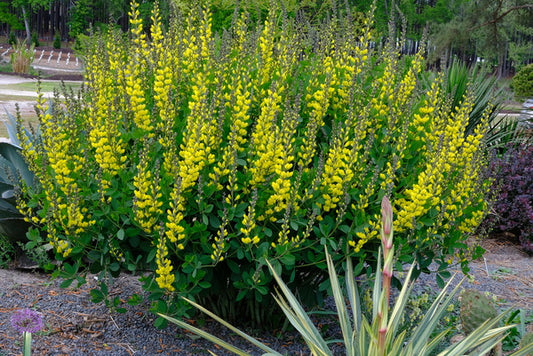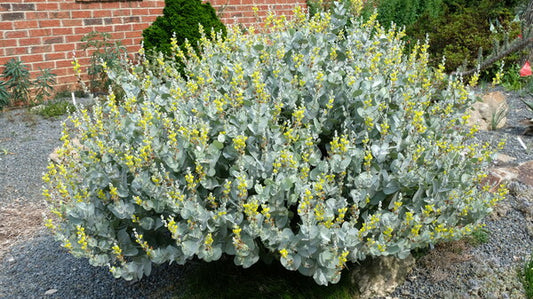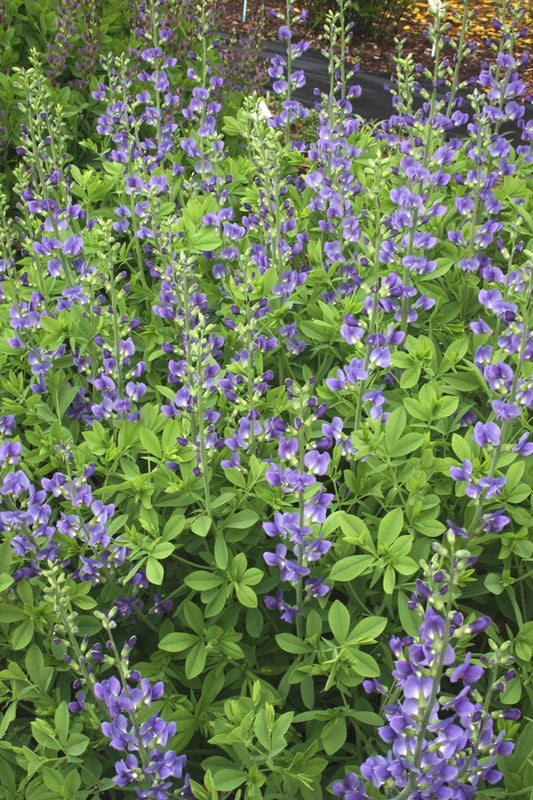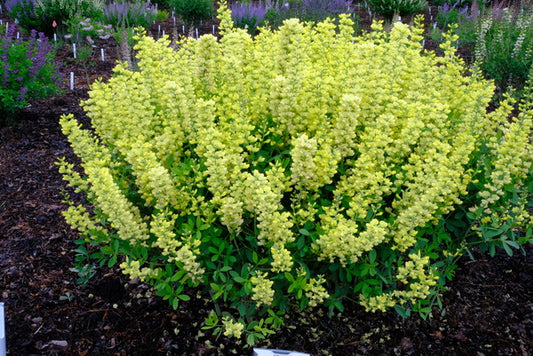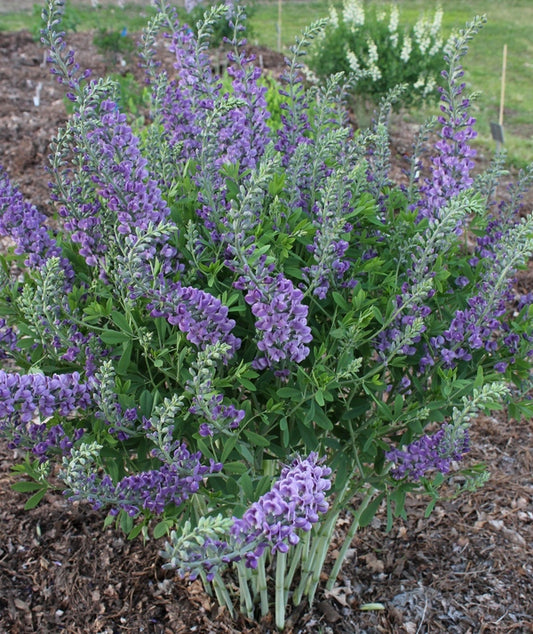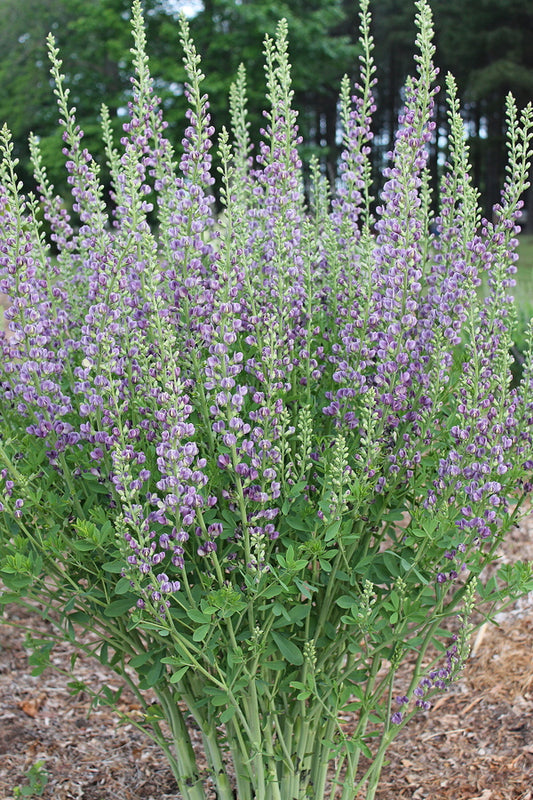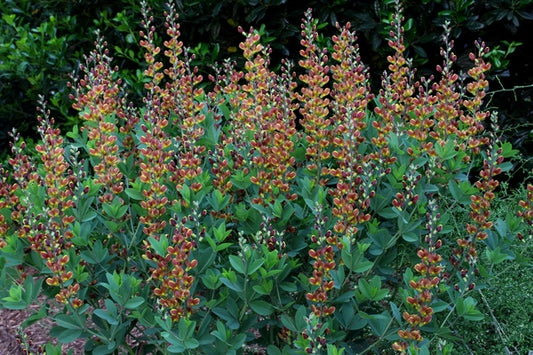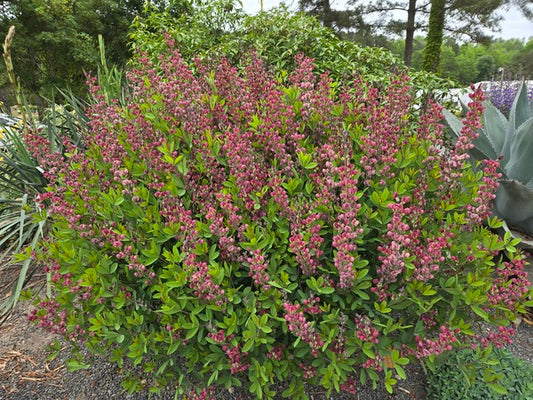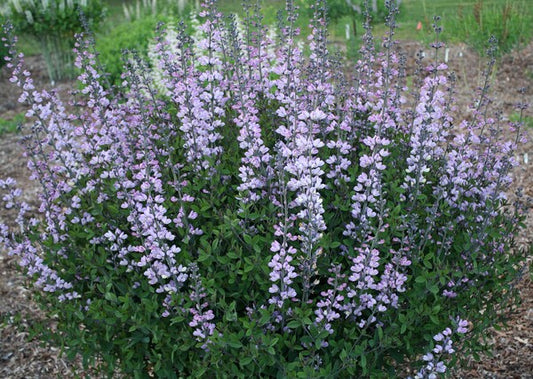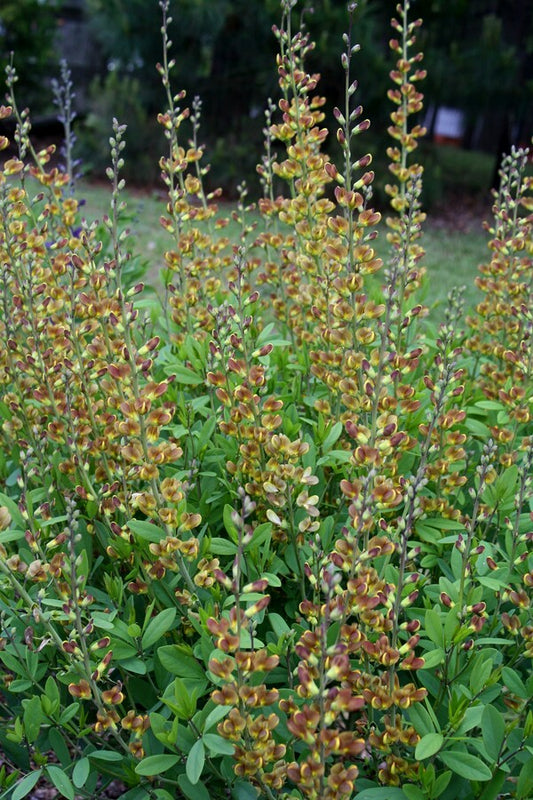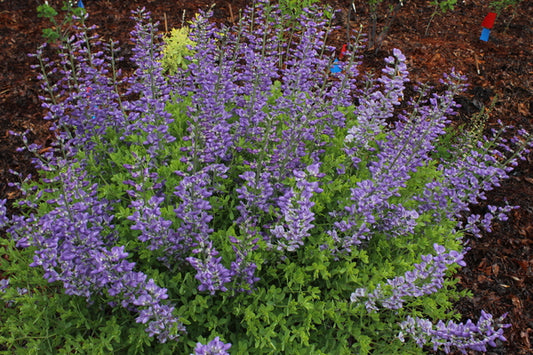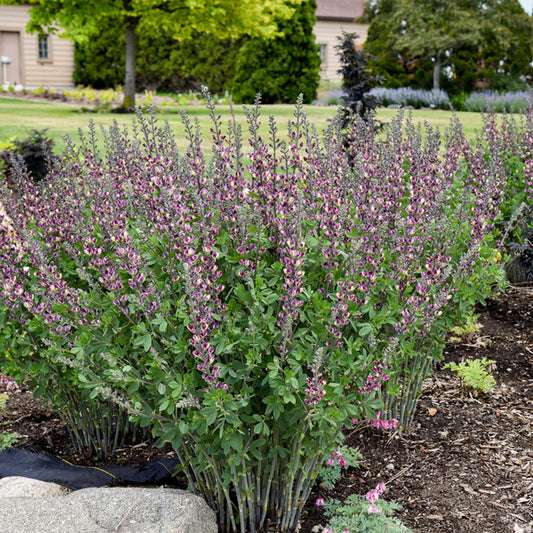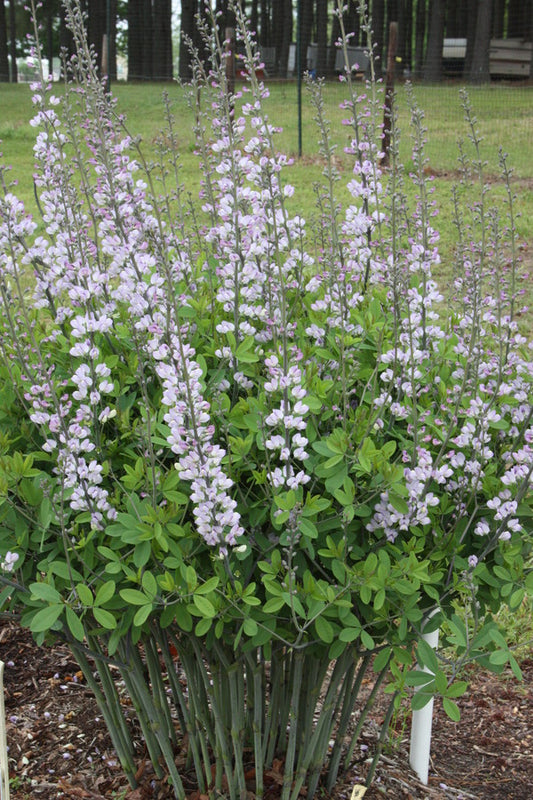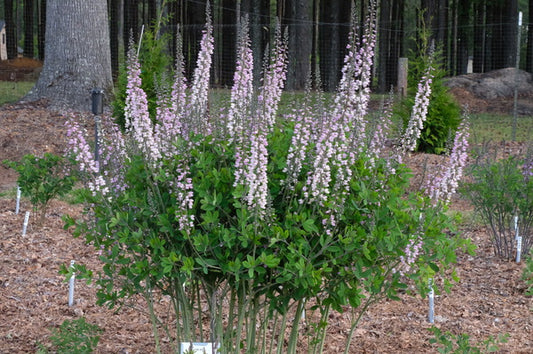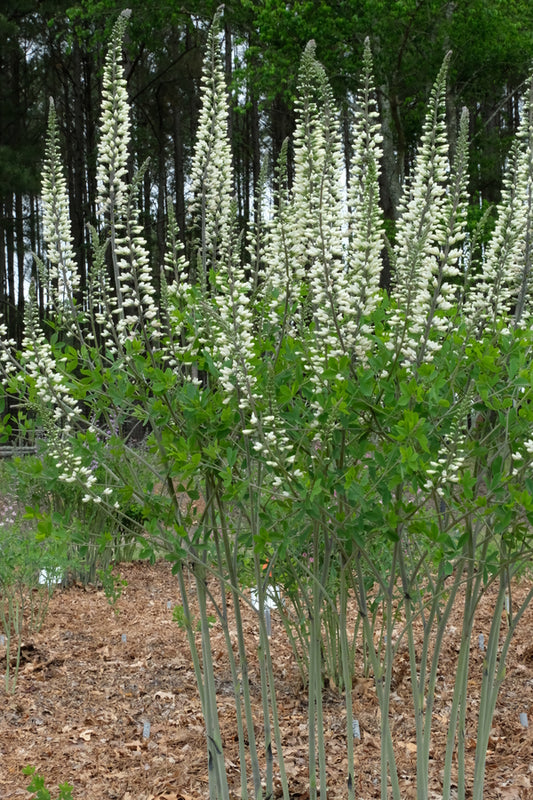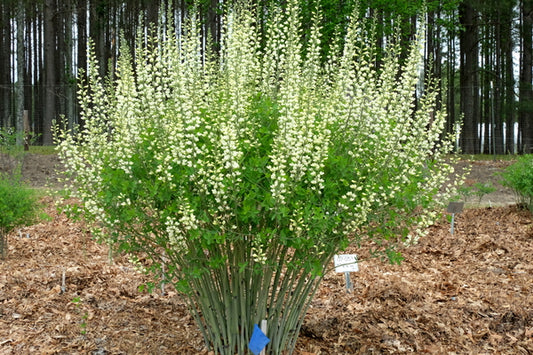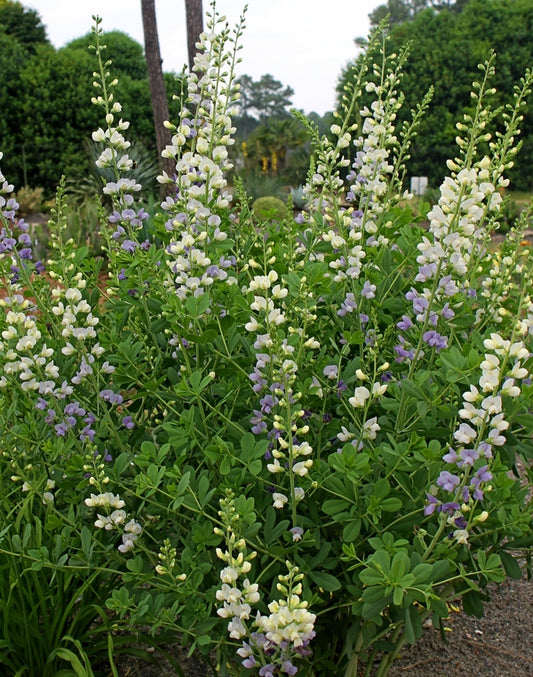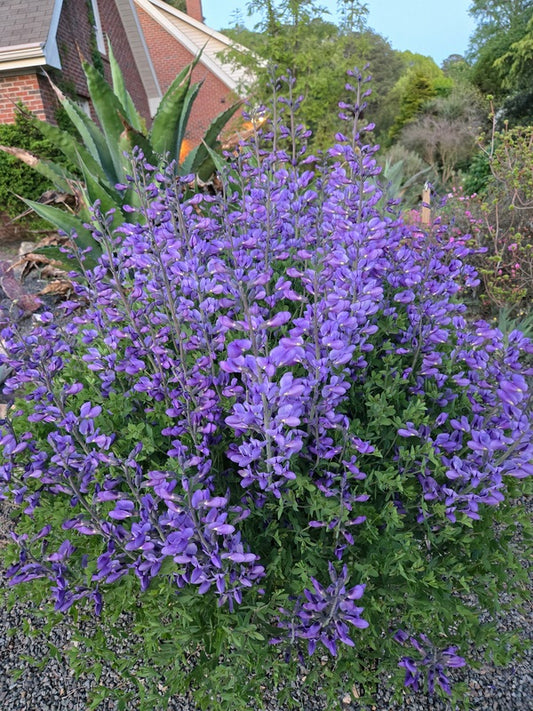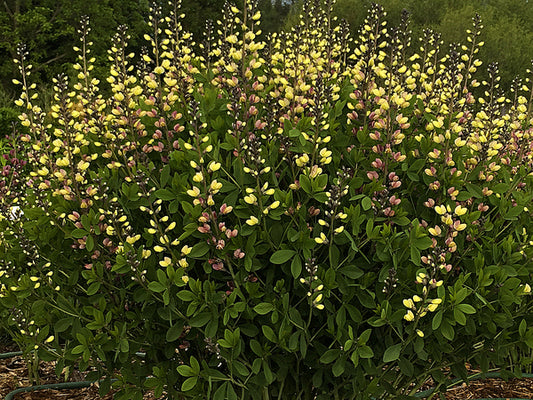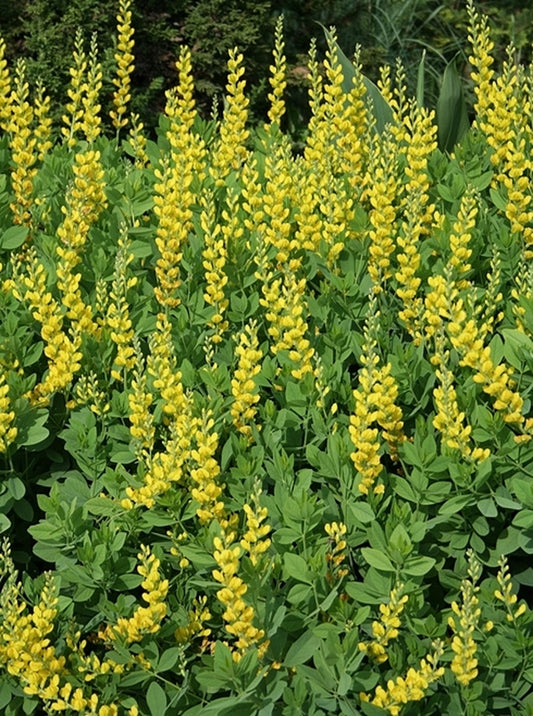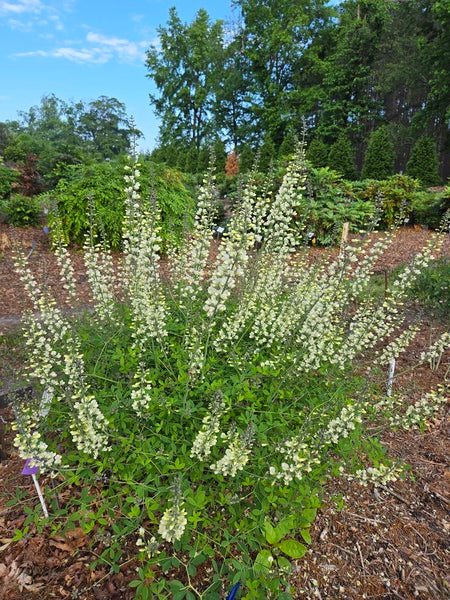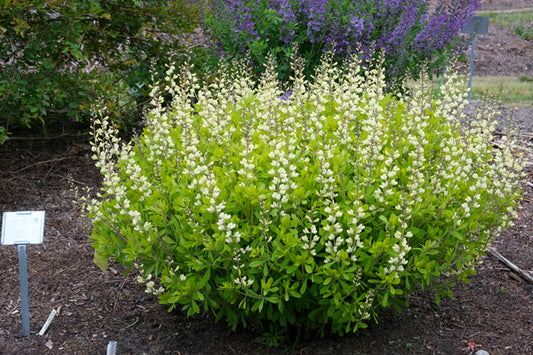Baptisia have long been one of our favorite groups of US native sun perennials, rivaling the famed lupine for beauty and structure, but far easier to grow and maintain. Baptisia plants are deer-resistant ornamental members of the pea family, most with blue-green foliage, topped by magnificent stalks of flowers in early spring. We are pleased to present a wide selection of the best sun garden species, as well as some of the most amazing hybrids you'll ever see. Baptisia hail from drier parts of the country...perfect for xeriscaping.
-
Baptisia 'American Goldfinch' PP 30,478
Item #: 17505
Zones: 4a to 9b
Dormancy: Winter
Height: 42" tall
Culture: Sun
Origin: United States Hybrid
Pot Size: 3.5" pot (24 fl. oz/0.7 L)
Regular price $24.00Regular priceUnit price per -
Baptisia arachnifera - NOT OUTSIDE NC
Item #: 510
Zones: 6a to 10b, possibly colder
Dormancy: Winter
Height: 24" tall
Culture: Sun
Origin: United States
Pot Size: 3.5" pot (24 fl. oz/0.7 L)
Regular price $30.00Regular priceUnit price per -
Baptisia australis
Item #: 1182
Zones: 4a to 9b
Dormancy: Winter
Height: 36" tall
Culture: Sun to Part Sun
Origin: United States
Pot Size: 3.5" pot (24 fl. oz/0.7 L)
Regular price $23.00Regular priceUnit price per -
Baptisia 'Blonde Bombshell' PP 26,828
Item #: 8740
Zones: 4a to 9b
Dormancy: Winter
Height: 40" tall
Culture: Sun
Origin: United States Hybrid
Pot Size: 3.5" pot (24 fl. oz/0.7 L)
Regular price $25.00Regular priceUnit price per -
Baptisia 'Blue Bunchkin'
Item #: 11848
Zones: 4a to 9b, at least
Dormancy: Winter
Height: 42" tall
Culture: Sun
Origin: United States Hybrid
Pot Size: 3.5" pot (24 fl. oz/0.7 L)
Regular price $25.00Regular priceUnit price per -
Baptisia 'Blue Candelabra'
Item #: 3951
Zones: 4a to 9b, at least
Dormancy: Winter
Height: 56" tall
Culture: Sun
Origin: United States Hybrid
Pot Size: 3.5" pot (24 fl. oz/0.7 L)
Regular price $25.00Regular priceUnit price per -
Baptisia 'Cherries Jubilee' PP 23,907
Item #: 9452
Zones: 4a to 9b
Dormancy: Winter
Height: 36" tall
Culture: Sun
Origin: United States Hybrid
Pot Size: 3.5" pot (24 fl. oz/0.7 L)
Regular price $24.00Regular priceUnit price per -
Baptisia 'Cherry Pie'
Item #: 3950
Zones: 4a to 9b
Dormancy: Winter
Height: 32" tall
Culture: Sun
Origin: United States Hybrid
Pot Size: 3.5" pot (24 fl. oz/0.7 L)
Regular price $25.00Regular priceUnit price per -
Baptisia 'Chrysalis'
Item #: 3946
Zones: 4a to 9b, at least
Dormancy: Winter
Height: 48" tall
Culture: Sun
Origin: United States Hybrid
Pot Size: 3.5" pot (24 fl. oz/0.7 L)
Regular price $25.00Regular priceUnit price per -
Baptisia 'Cinnamon Candles'
Item #: 3948
Zones: 4a to 9b
Dormancy: Winter
Height: 50" tall
Culture: Sun
Origin: United States Hybrid
Pot Size: 3.5" pot (24 fl. oz/0.7 L)
Regular price $25.00Regular priceUnit price per -
Baptisia 'Cloud 9'
Item #: 14274
Zones: 4a to 9b
Dormancy: Winter
Height: 48" tall
Culture: Sun
Origin: United States Hybrid
Pot Size: 3.5" pot (24 fl. oz/0.7 L)
Regular price $25.00Regular priceUnit price per -
Baptisia 'First Blush'
Item #: 3947
Zones: 4a to 9b, at least
Dormancy: Winter
Height: 52" tall
Culture: Sun
Origin: United States Hybrid
Pot Size: 3.5" pot (24 fl. oz/0.7 L)
Regular price $25.00Regular priceUnit price per -
Baptisia 'Grape Escape' PP 36,083
Item #: 18438
Zones: 4a to 9b
Dormancy: Winter
Height: 48" tall
Culture: Sun
Origin: United States Hybrid
Pot Size: 3.5" pot (24 fl. oz/0.7 L)
Regular price $24.00Regular priceUnit price per -
Baptisia 'Lavender Candles'
Item #: 8340
Zones: 4a to 9b, at least
Dormancy: Winter
Height: 48" tall
Culture: Sun
Origin: United States Hybrid
Pot Size: 3.5" pot (24 fl. oz/0.7 L)
Regular price $25.00Regular priceUnit price per -
Baptisia 'Lavender Towers'
Item #: 11843
Zones: 4a to 9b, at least
Dormancy: Winter
Height: 65" tall
Culture: Sun
Origin: United States Hybrid
Pot Size: 3.5" pot (24 fl. oz/0.7 L)
Regular price $25.00Regular priceUnit price per -
Baptisia 'Lighthouse'
Item #: 11837
Zones: 4a to 9b, at least
Dormancy: Winter
Height: 72" tall
Culture: Sun
Origin: United States Hybrid
Pot Size: 3.5" pot (24 fl. oz/0.7 L)
Regular price $25.00Regular priceUnit price per -
Baptisia 'Lightning Rods'
Item #: 14276
Zones: 4a to 9b, at least
Dormancy: Winter
Height: 60" tall
Culture: Sun
Origin: United States Hybrid
Pot Size: 3.5" pot (24 fl. oz/0.7 L)
Regular price $25.00Regular priceUnit price per -
Baptisia 'Lunar Eclipse' PP 25,875
Item #: 6077
Zones: 4a to 9b, at least
Dormancy: Winter
Height: 36" tall
Culture: Sun
Origin: United States Hybrid
Pot Size: 3.5" pot (24 fl. oz/0.7 L)
Regular price $24.00Regular priceUnit price per -
Baptisia minor 'Blue Bonnet'
Item #: 3716
Zones: 3a to 9b
Dormancy: Winter
Height: 30" tall
Culture: Sun
Origin: United States
Pot Size: 3.5" pot (24 fl. oz/0.7 L)
Regular price $27.00Regular priceUnit price per -
Baptisia 'Pink Lemonade' PP 30,669
Item #: 13183
Zones: 4a to 9b
Dormancy: Winter
Height: 48" tall
Culture: Sun
Origin: United States Hybrid
Pot Size: 3.5" pot (24 fl. oz/0.7 L)
Regular price $24.00Regular priceUnit price per -
Baptisia 'Purplicious'
Item #: 14275
Zones: 4a to 9b, at least
Dormancy: Winter
Height: 48" tall
Culture: Sun
Origin: United States Hybrid
Pot Size: 3.5" pot (24 fl. oz/0.7 L)
Regular price $25.00Regular priceUnit price per -
Baptisia sphaerocarpa 'Screamin' Yellow'
Item #: 5405
Zones: 4a to 9b, at least
Dormancy: Winter
Height: 36" tall
Culture: Sun to Part Sun
Origin: United States
Pot Size: 3.5" pot (24 fl. oz/0.7 L)
Regular price $24.00Regular priceUnit price per -
Baptisia 'Spiked Lemonade'
Item #: 17163
Zones: 4a to 9b, at least
Dormancy: Winter
Height: 60" tall
Culture: Sun
Origin: United States Hybrid
Pot Size: 3.5" pot (24 fl. oz/0.7 L)
Regular price $25.00Regular priceUnit price per -
Baptisia 'White Gold'
Item #: 11852
Zones: 4a to 9b
Dormancy: Winter
Height: 36" tall
Culture: Sun
Origin: United States Hybrid
Pot Size: 3.5" pot (24 fl. oz/0.7 L)
Regular price $25.00Regular priceUnit price per
More Information About Baptisia
The genus Baptisia (false indigo, false lupine or redneck lupine) is an incredible group of US natives (Minnesota south to Texas and east to Florida ... including North Carolina) that have long been one of our favorite groups of sun perennials. Baptisia species rival the famed lupine for beauty and structure but are far easier to grow and maintain. The genus name is derived from the Greek root bapto, which means to dip or to dye. This refers to its use as a substitute dye for indigo hence the common name - false indigo.
Baptisia are deer-resistant perennial wildflowers in the legume family, most have blue-green foliage topped by magnificent stalks of butterfly-attracting flowers...usually in spring. Plant Delights is one of the few nurseries working to make available some of the rarer summer-flowering baptisia species from the southeast US. Most gardeners are only familiar with the commonly grown blue baptisia, Baptisia australis, but baptisia come in a much wider range of flower colors that include white, yellow, purple, pink, red, and of course, blue. Named baptisia hybrids are dramatically improved over the wild species in terms of quantity of flower spikes, plant form, and of course, new color combinations.
Baptisia species hail from drier parts of the country, with amazing drought-tolerance, so once established they are perfect for xeriscaping. However, baptisia also thrive in moist conditions and are great perennials in a rain garden or as a marginal aquatic. Baptisia has been used in alternative medicine for hundreds of years by indigenous people and herbalists.
How to Grow and Care for Baptisia (False Indigo)
Where to Plant
Baptisia plants form long taproots which are great for drought tolerance but make successful transplanting difficult so choose your site carefully. False indigo can grow to 4 feet in height and width making them great background or border plants. Be ready to prune after spring to keep the size in check.
Best Time to Plant Baptisia
Baptisia are best planted anytime of the year that the ground is not frozen, being conscious of your hardiness zone. Fall or winter planting is not recommended if you are near the north end of the hardiness range for your baptisia.
Baptisia Sun Requirements
Baptisia australis, as well as other baptisia species, thrive in full sun but can tolerate part sun. As with most sun perennials, full sun results in more blooms.
Best Soil for Baptisia
Baptisia grow best in loamy soil and once established are incredibly drought tolerant.
Fertilizing
Baptisia is part of the legume family and like most legumes, can add nitrogen back to the soil so typically does not require additional fertilization. We recommend using organic fertilizers when needed.
Baptisia Pests and Diseases
False indigo is deer and rabbit resistant. Butterfly larvae (caterpillars) may dine on some of the foliage but baptisia typically recover quickly and it’s a small price to pay for the many butterflies they attract.
Baptisia Bloom Times
Baptisia flowers are typically blue, white, creamy yellow, and bright yellow but recent hybrids and crosses have resulted in more brown baptisia and pink baptisia variants available to gardeners. Blooms typically occur for 3 to 6 weeks in late spring or early summer depending on your zone.
Propagating Baptisia
Baptisia germinate easily from seed provided they are not too old. You can expect fresh sown seeds to sprout in two weeks. Plants started from seed can take a few years to flower. Named Baptisia plants are notoriously difficult to overwinter from rooted cuttings, so getting cuttings to form roots is only the first step. Baptisia need a long growing season after cuttings are rooted to form large enough underground growth buds to return the following season.
Baptisia Winter Hardiness
Baptisia are generally winter hardy as far north as Zone 4a.
Baptisia Companion Plants
Baptisia are perfect for background planting and pair well with shorter ground covers and other sun-loving perennials. Here are just a few of the baptisia companion plants that we recommend.
- Agave victoriae-reginae
- Alstroemeria
- Asclepias
- Echinacea
- Nepeta 'Cat Mint'
- Phlox
- Salvia greggii 'Big Pink'
- Sedum
- Solidago
- Yucca
- Paeonia
- Veronica umbrosa ‘Georgia Blue’
- Iris tectorum ‘Alba’
We are pleased to offer a wide selection of unique baptisia introductions including Baptisia ‘Angelina’, Baptisia ‘Aspiring’, and Baptisia ‘Cloud 9’. This is in addition to excellent hybrids like Baptisia ‘Lunar Eclipse' and Baptisia ‘Pink Lemonade' as well as the beautiful, blue-flowered, rock-solid wild blue baptisia species, Baptisia australis. Over the next few years, you'll be seeing more amazing baptisia hybrids hit the market including several from our own breeding as well as from our friend Hans Hansen. When you are ready to buy baptisia for your garden, check out our list of false indigo plants for sale.
Check out our in-depth article on Baptisia as well as Tony’s many baptisia blog posts over on the JLBG Blog.


